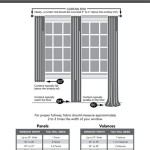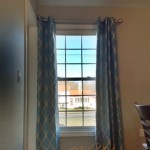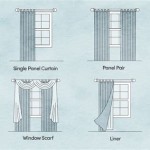How To Hang Curtains On Concrete Walls Without Drilling
Hanging curtains can significantly enhance the aesthetics and functionality of a room. They offer privacy, control light, and contribute to the overall décor. While the traditional method involves drilling into the wall to install curtain rods, this approach presents challenges when dealing with concrete walls. Concrete is notoriously difficult to drill into, requiring specialized tools and expertise. Furthermore, drilling can potentially damage the structural integrity of the wall and leave unsightly holes. Therefore, exploring alternative methods that allow for curtain hanging without drilling becomes essential for many homeowners and renters.
This guide provides a comprehensive overview of various techniques and materials that facilitate hanging curtains on concrete walls without drilling. It explores the advantages and disadvantages of each method, along with detailed instructions to ensure a successful and damage-free installation. By understanding these alternatives, individuals can achieve their desired window treatments without the hassle and potential complications associated with drilling into concrete.
Understanding The Challenges of Drilling Into Concrete
Before delving into the drill-free methods, it’s crucial to understand why drilling into concrete poses unique challenges. Concrete is a composite material consisting of cement, aggregates (sand and gravel), and water. This combination creates a dense, hard, and often brittle substance. Unlike drywall or wood, concrete resists penetration from standard drill bits. Attempting to drill into concrete without the proper tools and techniques can result in damaged drill bits, chipped concrete, and ultimately, a failed installation.
Furthermore, concrete walls often contain embedded pipes and electrical wiring. Drilling blindly into a concrete wall can inadvertently damage these utilities, leading to costly repairs and potential safety hazards. Locating these utilities beforehand requires specialized equipment and expertise, adding another layer of complexity to the drilling process. Even if utilities are avoided, drilling creates dust and debris, which can be messy and require extensive cleanup. Consequently, avoiding drilling altogether presents a more convenient and less disruptive alternative for hanging curtains.
Methods for Hanging Curtains Without Drilling
Several methods allow for hanging curtains on concrete walls without resorting to drilling. These techniques rely on adhesive technologies, tension mounting, or repurposing existing structures to support the curtain rods. Each method offers distinct advantages and limitations in terms of weight capacity, aesthetic appeal, and ease of installation. Carefully evaluating these factors will help determine the most suitable approach for a specific situation.
1. Adhesive Hooks and Rods: This is perhaps the simplest and most widely available method. Adhesive hooks and rods utilize strong adhesive strips to attach directly to the concrete wall. The adhesive is designed to provide a strong, temporary bond that can support a reasonable amount of weight. This option is best suited for lightweight curtains and sheer fabrics.
To install adhesive hooks, first clean the surface of the concrete wall with a damp cloth and allow it to dry completely. This ensures optimal adhesion. Then, peel off the backing from the adhesive strip and firmly press the hook onto the wall, holding it in place for the recommended time (usually 30 seconds to a minute). Allow the adhesive to cure for the specified duration (typically 24 hours) before hanging the curtain rod. For heavier curtains, consider using multiple hooks spaced evenly along the wall for added support. However, it is crucial to check the weight capacity of the adhesive hooks to ensure they can safely support the weight of the curtains and rod.
The main advantage of this method is its ease of installation and affordability. However, adhesive hooks may not be suitable for heavy curtains or thicker fabrics. The adhesive can also weaken over time, potentially leading to the hooks detaching from the wall. Additionally, removing the hooks can sometimes damage the paint or leave behind adhesive residue. When removing, use a hairdryer to gently warm the adhesive, making it easier to peel off without damaging the wall.
2. Tension Rods: Tension rods utilize a spring-loaded mechanism to create pressure against the walls of a window recess or doorway, providing a secure hold without the need for drilling. These rods are adjustable in length and can be easily installed and removed, making them an ideal solution for renters or those who prefer a temporary curtain solution.
To install a tension rod, simply extend the rod slightly longer than the width of the window recess or doorway. Then, compress the spring and carefully position the rod within the opening. Release the spring to allow the rod to exert pressure against the walls, securing it in place. It is essential to ensure that the tension rod is properly aligned and securely positioned to prevent it from slipping or falling. Tension rods are generally suitable for lightweight to medium-weight curtains, depending on the rod's diameter and the strength of the spring mechanism.
The advantage of tension rods is their ease of installation and removal, as well as their adaptability to various window sizes. However, they are limited to use within recessed areas and may not be suitable for hanging curtains on flat, exposed concrete walls. Furthermore, heavy curtains can cause the tension rod to slip, requiring frequent readjustment. It is also vital to consider the texture of the walls; smooth surfaces may not provide sufficient grip for the tension rod, increasing the risk of slippage.
3. Magnetic Rods: If the concrete wall has a metal frame or if a metal strip can be securely attached to the wall, magnetic rods offer another convenient solution. These rods utilize strong magnets to adhere to the metal surface, providing a stable support for curtains. Magnetic rods are particularly well-suited for metal door frames or window frames.
To install magnetic rods, simply position the rod against the metal surface. The magnets will automatically attach and hold the rod in place. Ensure that the magnets are strong enough to support the weight of the curtains and that the metal surface is clean and free of debris. Magnetic rods offer a clean and minimalist look and can be easily repositioned or removed as needed.
The primary limitation of this method is its reliance on a metal surface. If the concrete wall lacks a metal frame or if a metal strip cannot be securely attached, magnetic rods cannot be used. Furthermore, the strength of the magnets may vary, and it is crucial to choose a rod with magnets that are strong enough to support the intended weight. The type of metal also affects the magnetic adherence. Some metals, such as aluminum, are not magnetic.
Preparing The Concrete Surface
Regardless of the chosen method, proper preparation of the concrete surface is crucial for ensuring a successful and long-lasting installation. This involves cleaning the surface, addressing any imperfections, and priming the area if necessary.
Cleaning: Begin by thoroughly cleaning the concrete surface to remove any dust, dirt, grease, or debris. Use a damp cloth or sponge and a mild detergent to wipe the area clean. Rinse with clean water and allow the surface to dry completely. This step is essential for ensuring optimal adhesion for adhesive hooks or for providing a clean surface for tension rods to grip.
Addressing Imperfections: Inspect the concrete surface for any cracks, holes, or uneven areas. These imperfections can compromise the stability of the installation. Fill any small cracks or holes with concrete patching compound and allow it to dry according to the manufacturer's instructions. For larger imperfections, consider consulting a professional contractor. Leveling the surface ensures that the curtain rod is evenly supported and prevents it from tilting or falling.
Priming (Optional): In some cases, priming the concrete surface can improve adhesion, especially if the surface is porous or dusty. Apply a concrete primer according to the manufacturer's instructions and allow it to dry completely before proceeding with the installation. Priming creates a more uniform surface for the adhesive to bond to, increasing its holding power.
Choosing The Right Curtains and Hardware
The success of a drill-free curtain installation also depends on selecting the appropriate curtains and hardware. Consider the weight, fabric, and style of the curtains, as well as the material and design of the curtain rod.
Curtain Weight and Fabric: Opt for lightweight or medium-weight curtains made from fabrics like cotton, linen, or sheer materials. Heavy curtains made from thick fabrics can put excessive strain on the adhesive hooks or tension rods, increasing the risk of failure. Consider the light-blocking properties of the fabric; darker, denser fabrics will block more light than lighter, sheer fabrics.
Curtain Rod Material and Design: Choose a lightweight curtain rod made from aluminum or plastic. Avoid heavy metal rods, as they can exceed the weight capacity of the adhesive hooks or tension rods. Select a rod design that complements the style of the curtains and the overall décor of the room. Consider the diameter of the rod; a wider rod provides more stability and can support slightly heavier curtains.
Additional Considerations: Consider using curtain rings or clips to distribute the weight of the curtains more evenly along the rod. This can help prevent sagging or uneven hanging. Before making any permanent installations, test the weight capacity of the chosen method by temporarily hanging the curtains and rod and observing for any signs of weakness or instability.
Troubleshooting Common Problems
Even with careful planning and preparation, some common problems may arise during a drill-free curtain installation. Understanding these potential issues and knowing how to address them can help ensure a successful outcome.
Adhesive Hooks Detaching: If adhesive hooks detach from the wall, it may be due to insufficient surface preparation, excessive weight, or weakened adhesive. Clean the surface thoroughly, ensure that the weight of the curtains and rod does not exceed the hook's capacity, and consider using stronger adhesive strips. Applying a small amount of construction adhesive to the back of the hook can provide added holding power, but be aware that this may make removal more difficult.
Tension Rod Slipping: If a tension rod slips or falls, it may be due to improper installation, excessive weight, or smooth wall surfaces. Ensure that the rod is properly aligned and securely positioned, and consider using rubber or silicone grips to improve traction. Adding a thin layer of non-slip material to the ends of the tension rod can provide additional grip. If the walls are particularly smooth, consider lightly sanding the contact points to create a slightly rougher surface.
Curtains Sagging: If curtains sag or hang unevenly, it may be due to uneven distribution of weight or insufficient support. Use curtain rings or clips to distribute the weight more evenly along the rod, and consider adding additional adhesive hooks or tension rods for added support. Ensure that the curtain rod is level and that the curtains are properly balanced.

5 Easy Ways To Hang Curtains Without Drilling

Mastering The Art Step By Guide To Hanging Curtains On Concrete F J Outdoors

5 Easy Ways To Hang Curtains Without Drilling

How To Hang Curtains Without Drilling 2 Solutions

How To Hang Curtains Without Drilling 2 Solutions

5 Easy Ways To Hang Curtains Without Drilling

5 Easy Ways To Hang Curtains Without Drilling

How To Hang A Curtain Rod Without Drilling Into The Wall

5 Easy Ways To Hang Curtains Without Drilling

How To Hang Curtains Without Holes In The Wall








